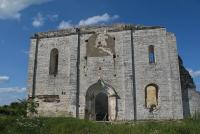Signs of life in NASA images from Mars (12 photos). Photos of Mars Latest images of Mars
New colored photo of the surface of the planet Mars 2019 high-resolution images with descriptions from NASA's Earth, Space Telescope and Mars Curiosity rover.
If you have never seen frosty deserts, then you need to visit the Red Planet. It didn't get its name by accident. photos of Mars from the Mars rover confirm this fact. Space– an amazing place where you can find completely unusual phenomena. So, the reddish color is created by iron oxide, that is, the surface is covered with rust. There are also amazing dust storms that show quality photo of Mars from space in high definition. Well, let’s not forget that for now this is the first goal in the search for extraterrestrial life. On our website you can see new real photos of the surface of Mars from rovers, satellites and telescopes from space.
High resolution photos of Mars
First photo of Mars
July 20, 1976 marked a turning point when Viking 1 captured the first photo of the surface of Mars. Its main tasks were to create high-resolution images to analyze the structure and atmospheric composition and look for signs of life.
Arsino-Chaos on Mars

On January 4, 2015, the HiRISE camera on MRO was able to capture a photograph of the surface of the Red Planet from space. This is the territory of Arsino-Chaos, located on the far eastern region of the Valles Marineris canyon. The damaged terrain may be based on the influence of massive water channels flowing in a northern direction. The curved landscape is represented by yardans. These are sections of rock that have been sandblasted. Between them there are transverse sandy ridges - Aeolian. This is a real mystery, hidden between the dunes and ripples. The point is located at 7 degrees south. w. and 332 degrees E. w. HiRISE is one of 6 tools on MRO.
Attack on Mars

Martian Dragon Scale

This interesting surface texture is created due to the rock's contact with water. Review performed by MRO. Then the stone collapsed and came into contact with the surface again. Pink indicates Martian rock that has become clayey. There is still little information about water itself and its interaction with stone. And this is not surprising, because scientists have not yet focused on solving such questions. But understanding this will help understand the past climate situation. The latest analysis suggests that early conditions may not have been as warm and wet as we would have liked. But this is not a problem for the development of Martian life. Therefore, researchers focus on terrestrial life forms that arise in dry and frosty areas. The scale of the Mars map is 25 cm per pixel.
Martian dunes

Martian ghosts

Martian rocks

Martian tattoos

Martian Niagara Falls

Escape from Mars

Surface Martian forms

The photo of the surface of Mars was taken with the HiRISE camera of the MRO apparatus flying in Martian orbit. Similar gully reliefs appear on many craters in mid-planetary latitudes. Changes began to be noticed for the first time in 2006. Nowadays many deposits are found in ravines. This photograph reflects new sediment in the southern mid-latitude Gasa Crater. The position is brighter in enhanced color photos. The image was mined in the spring, but the stream was formed in the winter. It is believed that the activity of the ravines awakens in winter and early spring.
Arrival and movement of Martian ice

Blue on the Red Planet

Follow the (bright) stream

Snowy Martian dunes

Mars Tattoos

Textures in Deuteronilus

It's been a good year for NASA's Mars surface robot, which has taken some stunning photos of the Red Planet over the past 12 months.
Since August 2012, the Curiosity rover has been traversing the Martian surface, gaining new insights into its environment. Where are the streams of water? Was there life here? And what happened at Gale Crater and Mount Aeolis? Now that the rover is on the lower mountain, it has captured some spectacular images of dunes, rocks and even a meteorite. Here are the most remarkable shots.
Dunes

Grab your 3D glasses and enjoy this 13-foot Martian dune! The Namib Dune was part of a study of active sand dunes (they migrate rapidly every year). The Namib is part of the Bagnold Dunes region, which are moving at a rate of one meter per year.
“As on Earth, sand dunes have a steep slope on their downwind side, called a glide face,” NASA said in a statement. “Sand grains blow from the windward side, creating mounds that then fall down like an avalanche. Then the process is repeated."
Sand selfie

This is another view of the Bagnold Dune region taken from the rover's front. This is not just a cool photo. It allows NASA engineers to monitor the status of the device. For example, the first cause for concern was how quickly the rover's wheels were being demolished. NASA started driving on nasty soil, which slowed the rate of wear and tear.
Mounds

Martian rock is an interesting thing to study because it tells a lot about the geological history of the planet. Here you can see some ridges on the sandstone within the Murray geological block. For some reason, these formations seem to have stopped the erosion.
"The site is located in the lower zone of Mount Sharp, where mudstones from the Murray Block (visible in the lower right corner) are exposed adjacent to the overlying Stimson Block," NASA said in a statement. “The exact line of contact between the two blocks is covered with wind-blown sand. Most other parts of the Stimson block did not show erosion-resistant nodules.”
Rocks

This magnificent panorama (including the craft's shadow on the right) shows the "Naukluft Plateau" at the bottom of Mount Sharp. Curiosity took a series of images on April 4, so geologists were able to understand the entire region (rock history).
“Since landing, the rover has passed through terrain containing aqueous sedimentary rocks (mudstones and siltstones, as well as early-stage accumulations), some of which contained minerals such as clay, indicating the ancient presence of water,” NASA says. “But on the new plateau, the rover found itself in a completely different geology. The sandstone here represents thick layers of windblown sand, suggesting that these deposits were deposited during a drier era."
Ripple and dust
Even the ripples on Mars are different. The largest ripples in the image are 10 feet apart. You won't see this on Earth. Although the small ones still resemble ours. This image was taken in December 2015 at the Bagnold dune field. The images were immediately sent back to Earth for publication, but sometimes take months to upload to get a better look.
“The images were taken in the early morning with a camera facing the Sun,” NASA writes. “This mosaic image has been manipulated to make the ripples more visible. The sand is very dark due to the morning shadows and the inner darkness of the minerals that dominate its composition.”
Autonomous pew-pew
Bye Laz  Black shooting by robots looks a little scary on Earth, but it was used peacefully on Mars. The rover selects targets for laser analysis using a program embedded in the software. So, if the device is in the right place, it can start working while scientists are trying to get their bearings. On the left frame you see the goal before the procedure, and on the right you see the result.
Black shooting by robots looks a little scary on Earth, but it was used peacefully on Mars. The rover selects targets for laser analysis using a program embedded in the software. So, if the device is in the right place, it can start working while scientists are trying to get their bearings. On the left frame you see the goal before the procedure, and on the right you see the result.
“The ChemCam laser spectrometer erases a nine-point grid on a stone selected according to specified criteria. In this case, the goal was to find bright exposed rock rather than dark rocks. Within 30 minutes of Navcam receiving the image, the laser completed its mission to the target area.”
Rocky beauty

What at first glance looks like a random assortment of rocks from the Murray Buttes actually says a lot about the long history of ancient Mars. While wind erosion dominates the planet, the image reveals important processes for the past. The instrument also found evidence of water erosion on the higher areas of Mount Sharp.
“These are the remains of ancient sandstone created by wind-deposited sand after the formation of lower Mount Sharp. The cross-bedding indicates that the sandstone was blown down by a migrating dune."
Vision of the future

The image was taken in late 2016, showing the view from the rover, including where it is headed next. The orange rock is the lower part of Mount Sharp. Above it is a layer of hematite, even higher is clay (difficult to see here). The Rounded Hills are a block of sulfate where Curiosity plans to head. Even further away are the high slopes of the mountain. The rover will be able to see them, but will not come close.
“The variety of colors hints at the difference in the composition of the mountain. Purple has already been noticed in other rocks in which hematite was identified. This season, the winds don't blow much sand, and the rocks are relatively free of dust (which can obscure the color)."
Alien visits

You can't even imagine how cool this is! A man-made rover roams an alien planet and stumbles upon an alien object. You're looking at an iron-nickel meteorite the size of a golf ball. It was called the "stone egg". “This is a general class of space rocks that have been discovered more than once on Earth. But this is the first time we have found something like this on Mars. It was examined using a laser spectrometer.”
Path through history

On August 7, 2012, Curiosity, a complex 900-kilogram rover equipped with the latest technology, began operating on the surface of Mars. In the future, Curiosity may become one of the most successful space missions: the scientific equipment on board is designed to study in detail the geological history of Mars and shed light on the question of life on this still mysterious planet. Despite the fact that the main work of the device will end after 668 Martian days, in total Curiosity is capable of operating for at least 14 years
Typical Martian landscape during the day
Part of the Gale Crater mosaic

Curiosity wheel track on the sand of Mars

Sand, dust and stone called Burwash. The picture was taken from a distance of 11.5 cm from the stone, the dimensions of the picture are 7.6 by 5.7 cm

Sand drift, from the slope of which Curiosity took soil samples. On the left we see a raw image of the dune, showing what it looks like on Mars, where the sky often has a reddish tint due to the large amount of dust. On the right, the image has been processed to show what the same area would look like on Earth. The size of the round stone above the center of the image is about 20 cm

“Blueberries” are small spherical inclusions in the Martian soil. The balls are about 3 mm in size, they contain a large amount of red iron ore, which is formed in the presence of water

The picture shows the bottom of the vehicle, all six wheels and the marks left by them. In the foreground are two pairs of black and white HAZCAM navigation cameras

Curiosity has just climbed the Rocknest dune to take the first soil samples of the Red Planet. The image was taken on October 3, 2012, on the 57th day of operation of the device

The MAHLI camera looks at Curiosity's wheel.

Morning on Mars

Dark gray Martian rock. The image was taken with a MAHLI camera from a distance of 27 cm. The area of the image is 16 by 12 cm, and the resolution is 105 microns per pixel. Despite its impressive clarity, scientists have been unable to resolve the granules or crystals that make up the stone.

The “Pyramid” on Mars is a rock called Jake Matijevic. The image was received on September 21, 2012.

Studying the "Pyramid" at close range. Chemical analysis of the stone showed that it is rich in alkali metals, as well as halogens - chlorine and bromine. Judging by the spectrum, this stone is a mosaic of individual grains of minerals, including pyroxene, feldspar and olivine. In general, the composition of the stone is very atypical for Martian rocks

Color image of a "pyramid" on Mars. The image has been white-balanced to reveal differences in the inclusions on the stone.

On the 55th day of stay on Mars. Curiosity's focus is on a sandy deposit called Rocknest, from the slope of which the rover took its first soil samples.

Remains of an ancient stream bed on Mars. The fact that water once flowed in this place is evidenced by many pieces of gravel and rocks that have a smooth round shape. In addition, the size of some of these pebbles suggests that they could only have been transported by a stream of water. The rock, chipped like a broken sidewalk, is of sedimentary origin

Looking back on the journey

Evening on Mars. The image was taken on day 49 of Curiosity's operation.

The Martian stone, which received the name Et-Then from scientists. The image was taken by the MAHLI camera (Mars Hand Lens Imager) on October 29, 2012, on the 82nd day of Curiosity’s stay on the Red Planet. The rock was photographed from a distance of 40 cm, the width of the image is only 25 cm. Et-Zen was discovered near the left front wheel of the device when Curiosity was preparing to take soil samples in the town of Rocknest

Rocks on Mars. Mosaic obtained by the MAHLI camera on the 76th day of Curiosity's stay on the Mysterious Planet

You all probably know that in August 2012 a truly grandiose event took place in the space industry. An entire scientific laboratory - the 900 kg Curiosity rover - has successfully landed on the surface of Mars.
The landing and operation of Curiosity can be considered one of the most successful missions. 
Typical landscape of the red planet
The equipment allows you to regularly send new photographs from Mars, as well as conduct various geological, chemical and weather studies of the red planet.
Today you won’t surprise anyone with a new photo of Mars from the Curiosity rover from Gale Crater, but during those 668 Martian days that it should plow the surface of the planet, we will probably hear about many new and interesting discoveries more than once.

All the photos we see he sends are from Gale Crater.
This place was not chosen by chance for landing. Barring any mishaps, the rover could theoretically operate for 14 years on the planet's surface.

The main goals of scientists are to study the geological history of the planet, as well as search for possible life or its traces in the past.
The rover is equipped with many cameras and even navigation ones. All pictures are obtained in black and white, and you can take pictures through various filters. By combining photos obtained through filters, they can be made in color, but they will differ slightly from the color that we would see with our own eyes. 
Well, while the rover is drilling the surface and shooting lasers at rocks, we suggest taking a look at the most interesting images. Enjoy watching.


Mars rover wheel mark



The Curiosity rover, also known as NASA's Mars Science Laboratory (MSL), is celebrating a special anniversary. For 2000 Martian days (sols), he has been exploring Gale Crater on the Red Planet.
During this period, the robot made many important observations. Having selected just a few of them, the team of scientists working with Curiosity has prepared some interesting ones for you.
Image copyright NASA/JPL-Caltech/MSSSABOUTlookingback. Throughout the history of the space age, we have received many spectacular images of planets. Many of them showed the Earth photographed from deep space.
This image from the Curiosity rover's Mastcam shows our planet as a faint speck of light in the Martian night sky. Every day, scientists from around the world fly Curiosity and study the Red Planet from 100 million miles away.
- Musk: a colony on Mars needs to be created before the world war
- Musk's electric car "crossed the orbit of Mars"
Start. The first image from Curiosity arrived 15 minutes after the rover landed on Mars on August 5, 2012.
Photos and other data come to us through the interplanetary station Mars Reconnaissance Orbiter (MRO), which appears above the robot at certain intervals, which determines the structure of the working day on Mars, or sols.
This photo shows a grainy image from a Front Hazard Camera device (which researchers typically use to avoid obstacles in their path). This is the final destination of our journey - Mount Sharp. When the image arrived, we knew the mission would be successful.
- Cosmic symbolism of Elon Musk
- Elon Musk: a rocket flight between cities around the world will take no more than half an hour
Reternalpebbles When we began to move along the surface of the planet (16 sols after landing), we soon came across these layers of pebbles.
The rounded shape of the fragments indicates that they were formed in an ancient shallow river. It flowed from the surrounding highlands, which were already four billion years old, and flowed into Gale Crater.
The inset image from the Mastcam device shows an enlarged view of the stone. Before the Mars Science Laboratory, we believed that the surface that was eroded by river water was all dark basalt. However, its mineralogical composition is not so simple.
- Elon Musk: the man who launched his convertible into space
A rock lying in the bed of this ancient river on Mars has changed our understanding of how the planet's igneous crust and mantle formed.
Image copyright NASA/JPL-CaltechPradavnherlake. Before the vehicle landed and during the initial stages of the mission, researchers did not yet know for sure what exactly they were seeing in the terrain images obtained from the HiRISE camera of the Mars Reconnaissance Satellite. These could be lava flows or lake sediments.
Without detailed close-up photographs "from the surface" there was no certainty. But this image ended the debate and marked a turning point in the study of Mars. The Yellowknife Bay area contains layers of fine-grained sand and silt formed by rivers flowing into the ancient lake of Gale Crater.
We drilled the first 16 holes here at the John Klein site on Sol 182. This is done in order to take rock samples and send them to the spectrometer contained in the body of our rover. Clay, organic matter and nitro compounds obtained from the analysis indicate that the area was once a favorable environment for microbial life. Whether there was life here remains to be determined.
Image copyright NASA/JPL-Caltech/MSSSDeep waters. Around Sol 753, the rover approached the Pahrump Hills. Working at this site has given us an invaluable opportunity to understand what the environment once was like in Gale Crater.
Here, the rover discovered thin layers of shale that formed as particles settled in the depths of the lake. This means that Lake Gale was a deep reservoir, the water in which stood for a very long time.
Image copyright NASA/JPL-Caltech/MSSSNopemating. Beginning on Sol 980, near Mount Stimson, the rover discovered a large layer of sandstone overlying lake sediments. So-called inconsistencies formed between them - a violation of the geological sequence of layers.
This geological feature marks a time when, after millions of years of existence, the lake finally dried up. Erosion began, leading to the formation of a new soil surface - evidence of events that took place over an "indefinite period of time." An example of such inconsistency was found by pioneer geologist James Hutton at Siccar Point on the coast of Scotland.
Image copyright NASA/JPL-Caltech/MSSSPeSki Pustyni. Curiosity approached the Namib dune on Sol 1192. It belongs to the large Bagnold dune cluster. These are the first active dunes we've explored on another planet, so Curiosity navigated its way forward very carefully because shifting sands are an obstacle for rovers.
And although the atmosphere on Mars is 100 times less dense than the earth’s, it is still capable of transporting sand, forming beautiful structures similar to those we see in the deserts on planet Earth.
Image copyright NASA/JPL-Caltech/MSSSINwindsculpturess. The Murray Buttes, photographed by Mastcam on sol 1448, were formed from the same sandstone that the rover discovered near Mount Stimson.
This is an area of dunes formed from lithified sandstone. They were the result of dune activity similar to what we saw in the modern Bagnold Strip. These desert deposits are located above the faults. This indicates that after a long period, the humid climate was replaced by an arid one, and the main factor in the formation of the environment in Gale Crater was the wind.
Image copyright NASA/JPL-Caltech/LANL/CNES/IRAP/LPGNantes/CNRS/IASABOUTpetrified silt. The Curiosity rover can analyze in detail the composition of rocks in the Gale Mountains. To do this, he uses a ChemCam laser and a telescope mounted on a mast. On Sol 1555, at Schooner Head, we came across ancient drying cracks of silt sediments and veins of sulfur rock.
On Earth, lakes are gradually drying up within their shores. This is what happened with Gale Lake here on Mars. Red marks mark the places in the rock where we aimed the laser. A small spark of plasma would appear, and the wavelength of light in the spark would tell us the composition of the shale and the veins.
Image copyright NASA/JPL-CaltechClouds in the sky. The rover took this sequence of images using navigation cameras (NavCam, Navigational Cameras) on Sol 1971, when we sent them into the sky. From time to time, on cloudy days, we can see fuzzy clouds in the sky of Mars.
These images are edited to highlight the difference and show how the clouds move across the sky. Three images show never-before-seen cloud patterns taking on a noticeable zigzag shape. Taking these images from start to finish took approximately twelve Martian minutes.
Image copyright NASA/JPL-Caltech/MSSSAboutpleadingselfieAnd. Over the years, thanks to the numerous selfies taken along the route, the Curiosity rover has earned such a reputation that it can easily compete with Instagram users.
However, these selfies are not just for self-admiration. They help the research team monitor the condition of work throughout the mission, because wheels can wear out and dirt accumulates. Curiosity takes these self-portraits using the Mars Hand Lens Imager (MAHLI), located on a mechanical manipulator - the “hand” of the work.
By merging many high-definition images, a photo is assembled. This particular photo was taken on Sol 1065 in the Buckskin area. It shows Curiosity's main mast with the ChemCam telescope, which is used to identify rocks, and the Mastcam camera.
In the foreground is a gray pile of waste rock particles (called tailings) left over from drilling.
Image copyright NASA/JPL-Caltech/MSSS Image caption Cooperstown - Darwin - Bradbury Site - Yellowknife Bay - Bagnold Dunes - Vera Rubin's Spine - Twin Craters - Highest point of the crater rim (from left to right)Beforelyingroad. This is a panoramic shot from a Mastcam device. It shows the path that the Curiosity rover has covered over the past 5 years: 18.4 km from the landing site (Bradbury) to its destination - on the Vera Rubin Ridge (VRR, Vera Rubin Ridge).
Previously, this ridge was called hematite - due to the high content of the mineral hematite (red iron ore), which scientists obtained from orbit.
Because hematite predominantly forms in the presence of water, the site is of great interest to the Curiosity team, which is studying changes in conditions at Gale Crater throughout its geological history.
This important site is ideal for Curiosity to celebrate its 2000th sol. And for us, this is an observation deck from which we can look back at the numerous discoveries made during the rover’s mission.
Follow our news on






